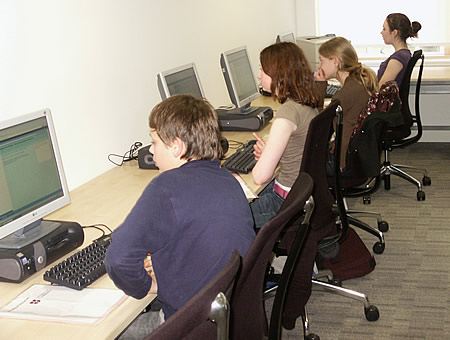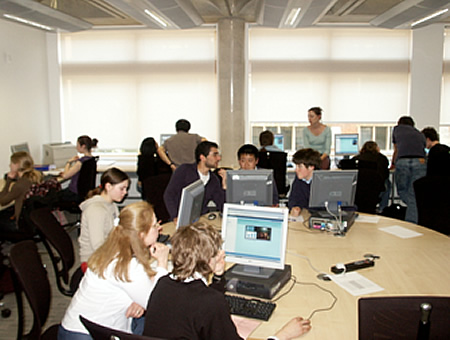| |
This activity was a computer-based learning
activity using level 3 (i.e. A level)
physics materials designed for student
self-study
|
|
| Overview of the activity |
| |
| The computer-based learning
(CBL) activity was atypical compared with most of
the ASCEND activities. It was not primarily related
to the nature of science theme, but rather was an
opportunity to work with some materials developed
for independent learning of physics in the post-16
sector (see Chapter 6). It also allowed students
to work independently, although they were allowed
to work together if they preferred. Students were
given the choice of working through a range of topics
from the National Learning Network (NLN) Level 3
Physics CBL materials. |
| |

Figure 6.1: The CBL task was set up as an individual
learning activity...
|
| |
| Rationale of the activity |
| |
This activity was provided
to give the students a taste of Physics at A level.
Physics is a highly abstract subject, involving
a good deal of mathematical formalism (albeit largely
limited to algebra at A level). These are features
that readily deter many students, but can be attractive
for more highly-attaining students.
The NLN materials were intended for use as independent
computer-based learning resources in further education
sector colleges. Materials used to introduce abstract
concepts without the presence of a teacher have
the potential to be confusing and frustrating unless
they are well designed. The NLN materials were produced
by a company (EPIC), which adopted a design based
on ideas about how learning is supported and reinforced.
The overall design of the units offered scaffolding
in learning. This attention to pedagogic considerations
made the materials suitable for providing introductions
to aspects of advanced physics for able learners. |
| |
‘He
was surprised to find out that g would also
decrease when going down a mineshaft, and was
able to follow the explanation using pendulum
motion’
(Observation
note on ASCEND delegate working on A level Physics
material)

Figure 6.2: …but support
was never far away
|
| |
| Resources |
| |
The NLN (National
Learning Network) independent learning materials
were funded by BECTA (the government funded British
Educational Communications and Technology Agency)
to provide resources to the further education (including
sixth form) sector (http://nln-materials.becta.org.uk/display.cfm?page=1630).
The level 3 physics units were designed to consist
of introductory and more advanced units across a
range of topics met in GCE A level and similar Physics
courses. In the ASCEND project students were advised
to select from the introductory units: |
| |
•
electricity-
conductivity and resistivity
• fields and
forces- the gravitational
field strength at different distances from
the Earth’s surface
• quantum
phenomena– demonstration
of the photoelectric effect
• radioactivity–
properties of alpha, beta and gamma radiation
• waves
– diffraction of water waves and light waves
|
|
| Each of these units
was considered to offer a taster of Physics study
post-GCSE that would be accessible for more able
students within the context of ASCEND. That is,
given the structured approach of EPIC’s design for
CBL, and the presence of science graduates offering
assistance, it was felt that these materials were
more likely to challenge and interest, rather than
challenge and frustrate, more able KS4 students. |
| |
| The following resources
are included on the CD: |
| |
| Resource |
Description |
Filename |
| Introduction |
Introduction
to the activity, and list of suggested
units to select from |
Act
6 Introduction |
|
|
|
| |
| The NLN materials
are available on the web. Teachers can register
to access the materials (http://www.nln.ac.uk/materials/). |
| |
| Download
PDF of activity 6 brief |
| |
|